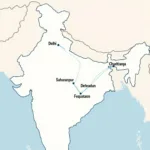New Hampshire, known for its scenic beauty and rich history, also holds secrets of abandoned airports. These remnants of a bygone era offer a fascinating glimpse into the past of aviation in the state. They tell tales of dreams of flight, technological advancements, and the changing landscapes of air travel. Let’s embark on a journey to uncover these forgotten airfields and the stories they hold. After the introduction, we will delve into the specifics of Abandoned Airports In Nh.
The Eerie Beauty of Abandoned Airports in NH
Abandoned airports possess a unique allure. Their deserted runways, crumbling terminals, and silent hangars evoke a sense of nostalgia and mystery. These spaces, once bustling with activity, now stand as silent witnesses to the passage of time. They offer a unique perspective on the evolution of air travel. Looking for more information on airport training? Check out our resources on airport training.
What leads to an airport’s abandonment? Several factors contribute to the demise of these once vital hubs. Economic downturns, shifts in air traffic patterns, and the development of larger, more modern facilities can all lead to an airport’s eventual closure. Sometimes, natural disasters or changing land use patterns also play a role. Regardless of the cause, these abandoned airports in NH offer a compelling look into aviation history.
 Overgrown Abandoned Runway in New Hampshire
Overgrown Abandoned Runway in New Hampshire
Pinpointing Abandoned Airports in NH: A Closer Look
While finding detailed information about every abandoned airport in NH can be challenging, some notable examples stand out. Many of these former airfields have been repurposed for other uses, such as industrial parks, residential areas, or even recreational spaces. Others remain untouched, slowly returning to nature. Exploring these locations can be a rewarding experience, offering a tangible connection to aviation’s past. You might be surprised to learn about the different areas near Delhi airport.
One example is the former Grenier Field in Manchester, NH. While not entirely abandoned, portions of the original airfield are no longer in use. Exploring these areas can provide insight into the airport’s earlier days. Similarly, smaller airfields scattered across the state have fallen into disuse, offering opportunities for urban exploration and historical research.
Why are Abandoned Airports in NH Left to Decay?
The reasons behind the decay of abandoned airports are multifaceted. Often, the cost of maintaining these large facilities becomes prohibitive. Security concerns, environmental regulations, and the lack of a clear plan for future use can also contribute to their decline. Preservation efforts are sometimes undertaken by local communities or aviation enthusiasts, but these initiatives often face significant challenges.
 Dilapidated Hangar at an Abandoned New Hampshire Airport
Dilapidated Hangar at an Abandoned New Hampshire Airport
“Abandoned airports are more than just empty spaces,” says Amelia Earhart Jones, a local aviation historian. “They’re time capsules, preserving fragments of our aviation heritage.” Their stories, though often hidden, are waiting to be rediscovered.
The Future of Abandoned Airports in NH
What does the future hold for these abandoned airports in NH? Some might be revitalized for new purposes, while others may remain as silent testaments to the evolution of flight. Documenting and preserving their history is crucial for future generations to understand the significant role aviation has played in shaping the state. For those interested in the world of airports, learning about an airport in GTA San Andreas can be a fun exploration into the virtual world of aviation.
Conclusion: Rediscovering the Past of Abandoned Airports in NH
The abandoned airports of New Hampshire offer a captivating blend of history, mystery, and a touch of melancholy. These forgotten airfields whisper stories of a time when aviation was still taking flight. Exploring these sites allows us to connect with the past and appreciate the advancements that have shaped modern air travel.
FAQ
-
Are there any abandoned airports in NH open to the public? Accessing abandoned properties can be dangerous and often illegal. It’s essential to research local regulations and obtain permission before exploring these areas.
-
Can I find a map of abandoned airports in NH? While comprehensive maps might not exist, online forums and aviation enthusiast communities can be valuable resources for information.
-
What are some common uses for repurposed abandoned airports? Abandoned airports are often transformed into industrial parks, residential areas, or recreational spaces like parks and hiking trails.
-
Are there any efforts to preserve abandoned airports in NH? Preservation efforts vary depending on the location and the historical significance of the airfield. Local historical societies and aviation groups might be involved in such initiatives.
-
Why is it important to document the history of abandoned airports? Documenting these sites helps preserve the history of aviation and provides valuable insights into the development of air travel in the region.
-
What challenges do preservation efforts face? Funding, environmental concerns, and securing ownership rights are common obstacles in preserving abandoned airports.
-
Where can I find more information about aviation history in NH? Local libraries, historical societies, and aviation museums are excellent resources for learning more about the state’s aviation heritage.
Looking for more resources? Check out our other articles or contact us for assistance.
Need Help? Contact Us:
Phone: +13089626264
Email: [email protected]
Address: 404 Bothwell St, Oxford, NE 68967, USA. We have a 24/7 customer service team.

